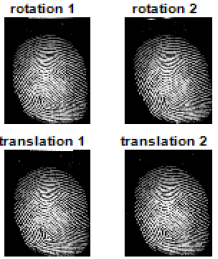Investigating the Thresholding Effect and Fingerprint Transformation Using Cross-Correlation Similarity Matching
DOI:
https://doi.org/10.62050/fscp2024.440Keywords:
Cross-correlation, elastic deformation, false acceptance rate, false rejection rateAbstract
This research presents a cross-correlation similarity matching method to study the fingerprint transformation and thresholding impact. This work directly compares the impact of various transformations (rotation, translation, elastic deformation, and scaling) on the fingerprint matching performance at different threshold values, in contrast to the standard minutiae-based systems. In order to compare the template positions of the two fingerprints using plots, the cross-correlation similarity matching of fingerprints first selects suitable templates in the primary fingerprint and then uses template matching to assess the impact of each transformation on matching accuracy, FRR, and FAR in the secondary print. The findings highlight the potential of thresholding in developing reliable and practical fingerprint recognition systems.
References
Yilmaz, I., & Abouyoussef, M. (Directors). (2023, May 11). FIGO: Fingerprint Identification Approach Using GAN and One Shot Learning Techniques [Video recording]. https://doi.org/10.1109/isdfs58141.2023.10131805.
Kang, H., Lee, B., Kim, H., Shin, D., & Kim, J. (2003). A Study on Performance Evaluation of Fingerprint Sensors. In J. Kittler & M. S. Nixon (Eds.), Audio- and Video-Based Biometric Person Authentication (pp. 574–583). Springer. https://doi.org/10.1007/3-540-44887-X_68
Yahya, F., Nasir, H., Kadir, K., Safie, S., Khan, S., & Gunawan, T. (2016). Fingerprint Biometric Systems. Trends in Bioinformatics, 9, 52–58. https://doi.org/10.3923/tb.2016.52.58
A.K. Jain, S. Prabhakar, L. Hong, and S. Pankanti, “Filterbankbased fingerprint matching,” IEEE Transactions on Image Processing, vol. 9, no. 5, pp. 846–859, May 2000
Bakheet, S., Al-Hamadi, A., & Youssef, R. (2022). A Fingerprint-Based Verification Framework Using Harris and SURF Feature Detection Algorithms. Applied Sciences, 12(4), 2028–2028. https://doi.org/10.3390/app12042028
Maltoni, D., Cappelli, R., & Meuwly, D. (2017). Automated Fingerprint Identification Systems: From Fingerprints to Fingermarks. In M. Tistarelli & C. Champod (Eds.), Handbook of Biometrics for Forensic Science (pp. 37–61). Springer International Publishing. https://doi.org/10.1007/978-3-319-50673-9_3
Chen, B., Lan, H., Ma, J., Zhang, L., Zhuang Xiong, & Fan, J. (2023, June 13). An improved weighted KNN fingerprint positioning algorithm | Wireless Networks. https://link.springer.com/article/10.1007/s11276-023-03400-x
Wyzykowski, A. B. V., & Jain, A. K. (Directors). (2023a, May 31). A Universal Latent Fingerprint Enhancer Using Transformers [Video recording]. arXiv (Cornell University). https://doi.org/10.48550/arxiv.2306.00231
S. Prabhakar, A.K. Jain, J. Wang, S. Pankanti, and R. Bolle, (2000). Minutia verification and classification for fingerprint matching. in Proceedings of ICPR2000, 15th Int. Conf. Pattern Recognition, Barcelona, Spain.

Downloads
Published
Issue
Section
License
Copyright (c) 2025 Proceedings of the Faculty of Science Conferences

This work is licensed under a Creative Commons Attribution-NonCommercial-ShareAlike 4.0 International License.


